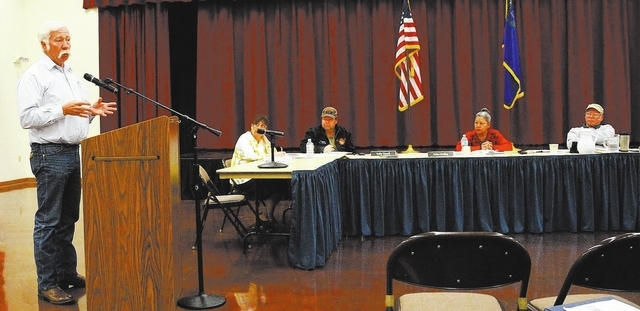
BEATTY — The gold-rush ghost town of Rhyolite may be booming again — audibly, at least.
Joe Strobbe, technical manager of WESCO, a Utah explosives company, came before the Beatty Town Advisory Board Jan. 13 to explain his company’s interest in utilizing the former Barrick Bullfrog mine site, adjacent to the historic mining town.
Strobbe said WESCO has been contacted by a company in the Netherlands about welding disparate metals together in a process using explosives.
This process will involve hanging very large tubes (approximately 20 feet in diameter) from cables. The explosions, each involving 100 pounds of high explosives, will take place inside the tubes.
He said that the plan is to fire off five of these explosions at the same time, and to arrange them so that some of the force they release into the air would be cancelled by each other. Each event would involve 500 pounds of explosives, and this would probably be done five or six times a day to meet production quotas.
Asked whether the explosions would have any effect on the historic structures in Rhyolite, Strobbe said that the blast would be comparable to a sonic boom and well below the 180 decibel level that causes structural damage. Since they would be air blasts, they would shake the ground less than the blasting that was done underground when the mine was active.
Speaking to the board and attending Beatty residents, Strobbe said, “Our big concern is how it’s going to affect you.”
He said that the topography is advantageous, since the site is higher in elevation than the town of Beatty, and the blasts would travel upward. There are also mountains between the mine site and the town. (Ladd Mountain and a large man-made hill are also between the blast site and Rhyolite.)
LaRene Younghans was concerned about the upward blast, saying that the site was on an approach to the Beatty airport. Crystal Taylor was similarly concerned about the effects on tourist traffic along the highway.
Strobbe said that it is standard practice to monitor and watch for breaks in traffic when setting off explosions. He also said that the duration of the blast was a second or less.
He said that you would see a white cloud from such explosions, but that it was not smoke, but steam at 7,000 degrees.
The company is also looking at possible sites in Arizona and northern Nevada, but Strobbe said he had come to Beatty first because the site has several advantages. For one thing, it is near a highway, and it is also near Las Vegas, to which the clients from the Netherlands can catch a direct flight. That company would spend several million dollars developing the site.
He said the operation would employ 8-10 workers at the blast site and perhaps 4-6 more in a shop where preparatory and other work would be done.
He explained that workers handling explosives cannot have a felony criminal record, and they have to undergo drug tests several times a year, beginning with a hair test.
He said the explosives would be stored according to government safety and security standards. He also said that they would use electronic detonators, containing a computer chip that would allow their detonation to be timed down to the mili-second. “Anyone who stole them would not be able to set them off without another $15,000 in equipment,” he said.
The company plans to set off a test blast sometime in February, which should give them and the community a good idea of any effects on the area. He also said that they would fine-tune the process as they went along to make it better.